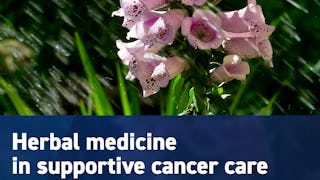This course provides an overview of essential oil therapy and current aromatherapy practices in clinical settings and gives you the skills to bring aromatherapy into your own practice. By the end of the course, you will be able to: a) explain what essential oils are to a patient and how they work; b) assess if an essential oil might be beneficial to a patient, considering patient preference and the research evidence, as well as any safety issues or contraindications; and c) suggest a protocol for use in a clinical setting.

Cultivate your career with expert-led programs, job-ready certificates, and 10,000 ways to grow. All for $25/month, billed annually. Save now


Aromatherapy: Clinical Use of Essential Oils
This course is part of multiple programs.

Instructor: Janet Tomaino, DNP
24,749 already enrolled
Included with 
(490 reviews)
Recommended experience
What you'll learn
Describe the current and potential role of aromatherapy in health and healthcare.
Identify safety and ethical issues and discuss their application in practice situations.
Assess, administer, and evaluate the use of essential oils for management of pain, anxiety, nausea, and fatigue.
Discuss logistics of establishing and sustaining a clinical aromatherapy program.
Details to know

Add to your LinkedIn profile
6 assignments
See how employees at top companies are mastering in-demand skills

Build your subject-matter expertise
- Learn new concepts from industry experts
- Gain a foundational understanding of a subject or tool
- Develop job-relevant skills with hands-on projects
- Earn a shareable career certificate


Earn a career certificate
Add this credential to your LinkedIn profile, resume, or CV
Share it on social media and in your performance review

There are 7 modules in this course
In this module, you'll get an overview of what aromatherapy is along with its historical, current, and potential roles in healthcare. We’ll also discuss the evidence base for aromatherapy and identify what information is available in an essential oil monograph.
What's included
18 videos3 readings1 assignment1 discussion prompt
Now that you’ve gotten an overview of aromatherapy and its uses, we’ll identify some important safety considerations to keep in mind when using essential oils, including skin reactions, special patient populations, product quality indicators, and FDA regulations. By the end of this module, you will have the skills to assess if a patient is a good candidate for essential oils and identify quality products.
What's included
10 videos5 readings2 assignments1 discussion prompt
In this module we’ll be exploring application methods of essential oils. Inhalation, compresses, baths, and diffusion are just a few of the ways essential oils can be used to enhance wellness. We’ll also examine the use of essential oils for self-care and discuss how they can benefit you in your personal life.
What's included
12 videos5 readings2 assignments1 discussion prompt
In this module we’ll discuss essential oils that can be used to manage pain and promote relaxation. How do essential oils work to reduce the perception of pain? What should you do if a patient wants to use essential oils for relaxation but is averse to certain scents? We’ll take a look at sweet orange, lavender, and bergamot monographs, as well as sweet marjoram and roman chamomile.
What's included
8 videos10 readings1 assignment1 discussion prompt
In this module we’ll explore essential oils that can be used to manage nausea and fatigue, including peppermint, spearmint, lemon, and grapefruit. We’ll identify therapeutic properties and safety considerations of each so you can feel confident using them in your practice.
What's included
7 videos10 readings
What's included
1 video1 reading1 peer review
In this module we will discuss how to establish and sustain a clinical aromatherapy program. We’ll provide you with some handy resources to consult when developing a program, including use tables, example policies, and a checklist for when you’re ready to put things into action.
What's included
5 videos8 readings1 discussion prompt
Instructor

Offered by
Recommended if you're interested in Research

University of Minnesota

University of Minnesota

University of Minnesota

Technion - Israel Institute of Technology
Why people choose Coursera for their career




Learner reviews
490 reviews
- 5 stars
89.38%
- 4 stars
8.77%
- 3 stars
1.22%
- 2 stars
0%
- 1 star
0.61%
Showing 3 of 490
Reviewed on Apr 3, 2024
This course helped me bring science to what was previously a hobby. It has motivated me to integrate aromatherapy into my work and explore the field in more depth.
Reviewed on Sep 24, 2023
The course is a good overview of the beginning of aromatherapy. Good resources for the monographs and basic introduction of the commonly used essential oils.
Reviewed on Jul 12, 2019
Amei!!!!Esse curso está abrindo tantas portas profissionalmente para mim que eu não tenho palavras para agradecer.Muito obrigada!!!!!
New to Research? Start here.

Open new doors with Coursera Plus
Unlimited access to 10,000+ world-class courses, hands-on projects, and job-ready certificate programs - all included in your subscription
Advance your career with an online degree
Earn a degree from world-class universities - 100% online
Join over 3,400 global companies that choose Coursera for Business
Upskill your employees to excel in the digital economy
Frequently asked questions
This course has been designed to meet Minnesota Board of Nursing continuing education (CE) requirements for 15 contact hours and may be eligible for CE credit from other professional boards that allow self-documenting of continuing education activities. It is your responsibility to check with your regulatory board to confirm this course meets your local requirements and, if necessary, to provide them with the certificate of completion you get if you pay for and fulfill all the requirements of this course.
Access to lectures and assignments depends on your type of enrollment. If you take a course in audit mode, you will be able to see most course materials for free. To access graded assignments and to earn a Certificate, you will need to purchase the Certificate experience, during or after your audit. If you don't see the audit option:
The course may not offer an audit option. You can try a Free Trial instead, or apply for Financial Aid.
The course may offer 'Full Course, No Certificate' instead. This option lets you see all course materials, submit required assessments, and get a final grade. This also means that you will not be able to purchase a Certificate experience.
When you enroll in the course, you get access to all of the courses in the Specialization, and you earn a certificate when you complete the work. Your electronic Certificate will be added to your Accomplishments page - from there, you can print your Certificate or add it to your LinkedIn profile. If you only want to read and view the course content, you can audit the course for free.
More questions
Financial aid available,

